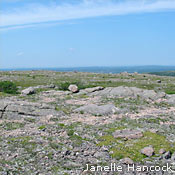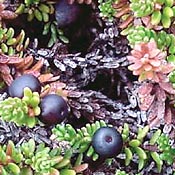Only 50 km west of St. John’s on the Island of Newfoundland, the Hawke Hill Ecological Reserve protects a variety of arctic-alpine plants that are rarely encountered in North America this far east and south. The area can, in fact, be called the most easterly alpine barrens in North America.
These open barrens belong to the Maritime Barrens-Southeastern Barrens subregion (1.1 MB) and the reserve captures the best representative area of alpine barrens east of Newfoundland’s Long Range Mountains.

- How to get There
- Activities
- Maps
- Services
- Fees and Schedules
- Rules and Regulations
- Permits
- Other Resources
- Contact Information
The reserve is often covered by cold fog moving in off the Atlantic. Its elevation and weather conditions keep the area cool even in summer, which is why the arctic-alpine plants are able to survive here. Arctic-alpine species found here include diapensia, alpine bearberry, black crowberry, and threetooth cinquefoil.
The reserve also has low-growing plants that are well-adapted to exposed conditions and soils low in nutrients, including fir and spruce tuckamore. In addition, you can see “patterned ground” in open, windswept locations. The natural arrangement of these stones in rough geometric shapes or lines is caused by exposure to severe weather conditions and exaggerated freeze-thaw cycles (especially where winds keep snow cover thin).
The 1.3 km2 Hawke Hill Ecological Reserve was given provisional reserve status in 1990, and fully designated in 1992. As early as the 1970s, a site just north of the current reserve was identified for protection under the International Biological Program. Before a reserve was created, some of the plant life there was destroyed by the construction of a microwave network and associated maintenance roads. This further emphasized the need for a reserve to protect a portion of this unique ecosystem.
How to get there

Hawke Hill Ecological Reserve is located on some of the highest ground on Newfoundland’s Avalon Peninsula, about 50 km west of St. John’s. It is accessed on foot (no motorized vehicles permitted), and is about 3 km east of Salmonier Line/Trans-Canada Highway junction.
The reserve is accessible by hiking two unmarked routes. The first route leaves from a communication tower located off the Trans Canada Highway 1.5 km southwest of the Route 62 Trans Canada Highway overpass. Hikers can also leave from the Transmission Line which parallels the TCH and crosses the Witless Bay Line.
Activities
Hiking into and through the reserve is possible, though visitors are asked to walk carefully so as not to disturb the plants. You are advised to take a compass and map-fog can roll in and quickly obscure landmarks. No ATV or snowmobile use is permitted.
Scientific research and educational programs are the main activities that take place in the reserve. For more information and research guidelines, see Science & Research.
Because of the vulnerability of the plants, camping, hunting, and trapping are not permitted, and building fires is prohibited.
Services
There are no services in the reserve.
Fees and Schedules
There are no fees involved in obtaining scientific research, commercial operator or educational tour permits.
Rules and Regulations
Biodiversity protection and habitat conservation are two of the key purposes of ecological reserves, so certain rules apply within all the reserves in the province.
The public can visit most ecological reserves for educational purposes or low-impact recreational activities, such as hiking or sightseeing.
At the Hawke Hill Ecological Reserve:
- No entry permit is required, though visitors are asked to avoid walking on the tiny arctic-alpine plants while in the reserve.
- Because of the vulnerability of the plants, camping, hunting, fishing, and trapping are not permitted in the reserve, and building fires is prohibited.
- Taking seeds or plant cuttings is also prohibited.
The following activities are strictly prohibited in all wilderness and ecological reserves:
- Disturbing, destroying, or removing plants, animals, or fossils
- Introducing plants, animals, or anything else to the reserve landscape
- Forestry, mining (including exploration), hydro development, agriculture, new roads, tracks, or building construction
- Driving off-road vehicles including all-terrain vehicles (ATVs)
Read the official reserve regulations:
- Botanical Ecological Reserve Regulations
- Hawke Hill Ecological Reserve Order
- Wilderness and Ecological Reserves Act
Regulations and a management plan are pending for the Hawke Hill Ecological Reserve.
Adobe® Acrobat® Reader software can be used for viewing PDF documents. Download Acrobat® Reader for free
